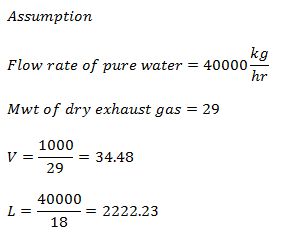In this case or generally in absorption, the operating line lays above the equilibrium curve/line whereas in distillation and stripping the reverse is true. Why?
In this case or generally in absorption, the operating line lays above the equilibrium curve/line whereas in distillation and stripping the reverse is true. Why?
Introduction to Chemical Engineering Thermodynamics
8th Edition
ISBN:9781259696527
Author:J.M. Smith Termodinamica en ingenieria quimica, Hendrick C Van Ness, Michael Abbott, Mark Swihart
Publisher:J.M. Smith Termodinamica en ingenieria quimica, Hendrick C Van Ness, Michael Abbott, Mark Swihart
Chapter1: Introduction
Section: Chapter Questions
Problem 1.1P
Related questions
Question
100%
- An effluent gas from a food processing industry with a flow rate of 1000 mol/h is to be processed. It contains 10mol% SO2 and the remaining balance of an inert gas. Due to environmental restriction, the industry should absorb the SO2 in the original effluent with 92% of absorption efficiency before emission to the environment. For this task, pure water is employed as a solvent since SO2 is highly soluble in water. The equilibrium data is given hereunder in molar ratio. The operating line is a straight line and is represented by
|
X (104 ) |
0 |
1 |
4 |
6 |
8 |
10 |
12 |
|
Y (103 ) |
0 |
8.8 |
36.3 |
55.5 |
75.4 |
96 |
117.5 |
Determine:
- The amount of solute and inert gas in feed
- The inlet and outlet concentration of solute in mole ratio
in the gas phase
- The inlet and outlet concentration of solute in mole ratio
in the liquid phase
- Theoretical number of stages required
- In this case or generally in absorption, the operating line lays above the equilibrium curve/line whereas in distillation and stripping the reverse is true. Why?
Expert Solution
Step 1: Calculate Concentration of the liquid and vapor phase

Step by step
Solved in 6 steps with 7 images

Knowledge Booster
Learn more about
Need a deep-dive on the concept behind this application? Look no further. Learn more about this topic, chemical-engineering and related others by exploring similar questions and additional content below.Recommended textbooks for you

Introduction to Chemical Engineering Thermodynami…
Chemical Engineering
ISBN:
9781259696527
Author:
J.M. Smith Termodinamica en ingenieria quimica, Hendrick C Van Ness, Michael Abbott, Mark Swihart
Publisher:
McGraw-Hill Education

Elementary Principles of Chemical Processes, Bind…
Chemical Engineering
ISBN:
9781118431221
Author:
Richard M. Felder, Ronald W. Rousseau, Lisa G. Bullard
Publisher:
WILEY

Elements of Chemical Reaction Engineering (5th Ed…
Chemical Engineering
ISBN:
9780133887518
Author:
H. Scott Fogler
Publisher:
Prentice Hall

Introduction to Chemical Engineering Thermodynami…
Chemical Engineering
ISBN:
9781259696527
Author:
J.M. Smith Termodinamica en ingenieria quimica, Hendrick C Van Ness, Michael Abbott, Mark Swihart
Publisher:
McGraw-Hill Education

Elementary Principles of Chemical Processes, Bind…
Chemical Engineering
ISBN:
9781118431221
Author:
Richard M. Felder, Ronald W. Rousseau, Lisa G. Bullard
Publisher:
WILEY

Elements of Chemical Reaction Engineering (5th Ed…
Chemical Engineering
ISBN:
9780133887518
Author:
H. Scott Fogler
Publisher:
Prentice Hall


Industrial Plastics: Theory and Applications
Chemical Engineering
ISBN:
9781285061238
Author:
Lokensgard, Erik
Publisher:
Delmar Cengage Learning

Unit Operations of Chemical Engineering
Chemical Engineering
ISBN:
9780072848236
Author:
Warren McCabe, Julian C. Smith, Peter Harriott
Publisher:
McGraw-Hill Companies, The